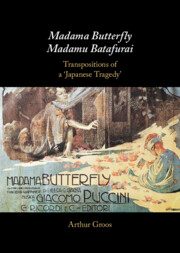Book contents
- Madama Butterfly/Madamu Batafurai
- Madama Butterfly/Madamu Batafurai
- Copyright page
- Dedication
- Contents
- Illustrations
- Musical Examples
- Preface
- Acknowledgments
- Note on the Text
- Abbreviations
- Introduction: “Marriage… in the Japanese Way”
- 1 Loti and Long – with an Eyewitness Account
- 2 Madama Butterfly: A Conflicted Genesis
- 3 Far West/Far East: Luigi Illica’s Libretto
- 4 Madama Butterfly between West and East
- 5 Returns of the Native: Madamu Batafurai in Japan
- 6 Returns of the Native: Imaginative Transpositions
- Brief Epilogue
- Bibliography
- Index (by Tanya Izzard)
5 - Returns of the Native: Madamu Batafurai in Japan
Published online by Cambridge University Press: 09 February 2023
- Madama Butterfly/Madamu Batafurai
- Madama Butterfly/Madamu Batafurai
- Copyright page
- Dedication
- Contents
- Illustrations
- Musical Examples
- Preface
- Acknowledgments
- Note on the Text
- Abbreviations
- Introduction: “Marriage… in the Japanese Way”
- 1 Loti and Long – with an Eyewitness Account
- 2 Madama Butterfly: A Conflicted Genesis
- 3 Far West/Far East: Luigi Illica’s Libretto
- 4 Madama Butterfly between West and East
- 5 Returns of the Native: Madamu Batafurai in Japan
- 6 Returns of the Native: Imaginative Transpositions
- Brief Epilogue
- Bibliography
- Index (by Tanya Izzard)
Summary
Surveys the first decades of Madama Butterfly’s reception in Japan, which motivated de-orientalizing productions that changed or deleted passages considered comically inaccurate or insulting, often reimagining the heroine as an exemplar of pure-hearted Japanese womanhood. Discussion concentrates on three landmark productions. (1) A partial first staging (1914), featuring soprano Takaori Sumiko and her conductor husband Shuichi, who created a scandal with encores that included a celebration of strip-tease dances in treaty-port teahouses. (2) A “corrected” production (1930) by composer Yamada Kosaku and translator Horiuchi Keizo. The score and libretto were drastically emended by changing Puccini’s borrowings from Japanese music and deleting the entire wedding scene and other offensive passages, thus suppressing the opera’s location in late nineteenth-century treaty-port culture. (3) A 1936 production of the opera by Miura Tamaki, the most famous Japanese soprano of the period, celebrating her return to Japan from a career abroad. It legitimized the heroine’s marriage by adding a Shinto priest and emphasizing the tragedy of her maternal sacrifice.
Keywords
- Type
- Chapter
- Information
- Madama Butterfly/Madamu BatafuraiTranspositions of a 'Japanese Tragedy', pp. 177 - 208Publisher: Cambridge University PressPrint publication year: 2023

